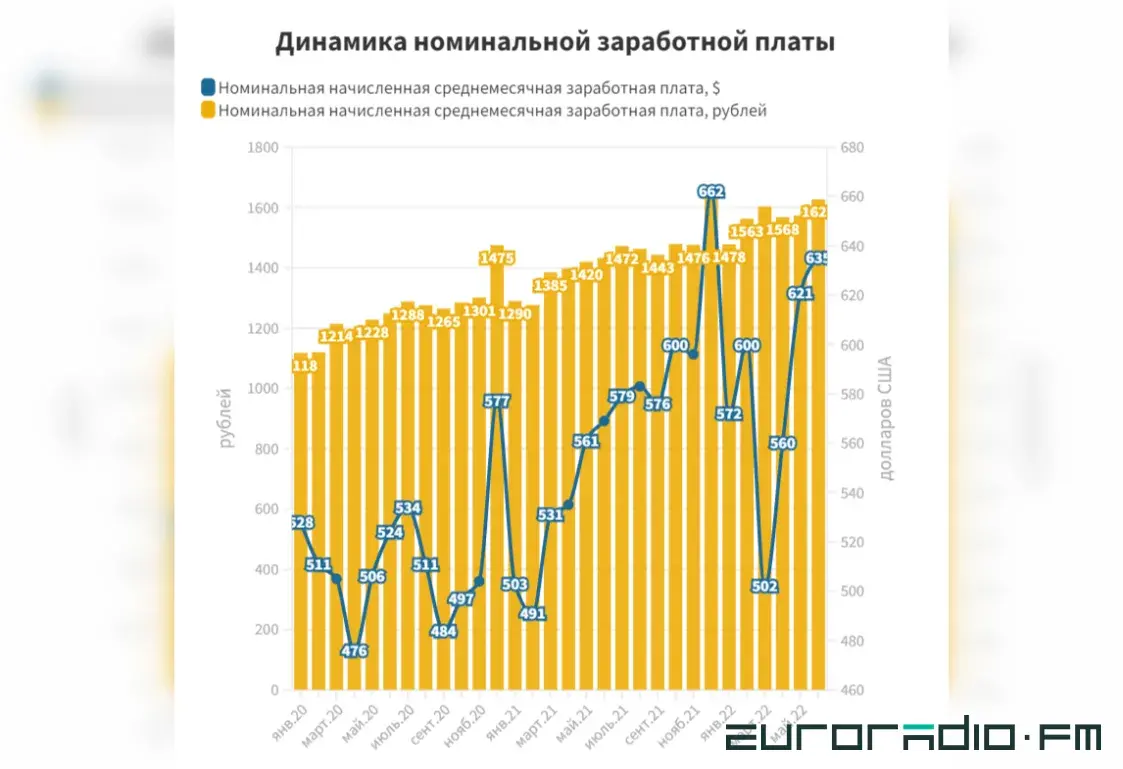Real Belarusian salaries are growing only on TV

Belarusians wouldn't have to save on food if life were like it is on the state TV / collage by Ulad Rubanau, Euroradio
Officials often report about the growth of wages in Belarus and the average wage reaching five hundred USD. Many Belarusians might wonder where the money is and why they don't have it.
The experts of "Kosрt Urada" (cost of government) recently prepared a review where they explained why the desired average wage is much less often found in real life and where the money really is.
"Five hundred," says the payslip, but you must also pay taxes and account for price growth
There's not much point in estimating nominal wages. It's only what we see in the payslip in the "accrued" column. What really matters is the real wage. This is our "accrued," but taking into account inflation and deducting taxes - 13% of income tax if there are no benefits, and 1% of the Social Security Fund.
"Unfortunately, in Belarus, we often hear from the officials the figures associated with the nominal wage, which allows us to play with numbers and hide the really important indicators behind secondary ones," say the experts. "Look at the graph with nominal and real wages in Belarus over the past two and a half years. It immediately becomes clear: while the nominal wage shows a relatively steady growth from month to month, the real wage behaves quite differently. Its growth has been slowing in recent years".
Salary in rubles and US dollars
"Fact: Overall, nominal wages have been rising in recent years. While at the beginning of 2020, this figure was 1,118 rubles, by mid-2022, it was more than 1,627 rubles, i.e. increased nearly one and a half times over two and a half years. The growth in dollars is not as rapid. In January 2020, the average normal wage in hard currency was $528, while in June 2022 - $635, or 20% more," writes Kosht Urada.
"The officials prefer to keep silent about the fact that high rates of salary in dollars are just the accrued income, from which income tax and social security must be deducted. That's why the national average of $635 turns into three or four hundred pumpkins in most regions.
The regions lag 10-20% behind Minsk
Officials can juggle with beautiful indicators without mentioning the income gap between regions.
"When the national average nominal wage was 1,627 rubles [in June - Euroradio], all regions, except Minsk, had significantly lower figures. From 1,327 in Mahiliou region to 1,457 in Homiel region. The metropolitan figures, by contrast, were much higher - around 2,264 BYN.
"Salary has been growing steadily since the beginning of the year: in January, it was 1,595 rubles, while in June it was already 1,993 rubles. In the future, it will not be easy to trace this trend because since July the information on salaries in this sector has been removed from public sources. I wonder why. In addition, there are high salaries in finance (2,339 rubles) and scientific research (2,306 rubles)".
"IT turned out to be surprisingly resistant to crises, government oppression and sanctions. In July, it was the only sphere that made a positive contribution to the GDP".
One of the interesting trends here is the narrowing of the gap between the salaries of IT specialists and all other workers.
"While in January 2016, IT salaries differed from the average in Belarus by 5.6 times, in mid-2022, the difference was already 3.8 times. What happened? Besides the obvious (IT workers' salaries didn't grow as fast as salaries in Belarus as a whole), there's another interesting phenomenon. IT specialists received large salaries, which, like through a sieve, penetrated further into the country's economy, feeding the service sector, producing and stimulating the emergence and development of many businesses. This means that most of these businesses will suffer if there are no more IT people".
This flow of funds to other spheres can become a trigger for a decrease in real wages in the future. After all, IT specialists are mobile, and their conditions in Belarus are getting worse.
"In the last few months alone, the industry has already lost 5% of its employees, and apparently, those were the most highly paid and in-demand ones. The magic with which money leaked from IT to other spheres is melting before our eyes," summarize the experts of Kosht Urada.





















